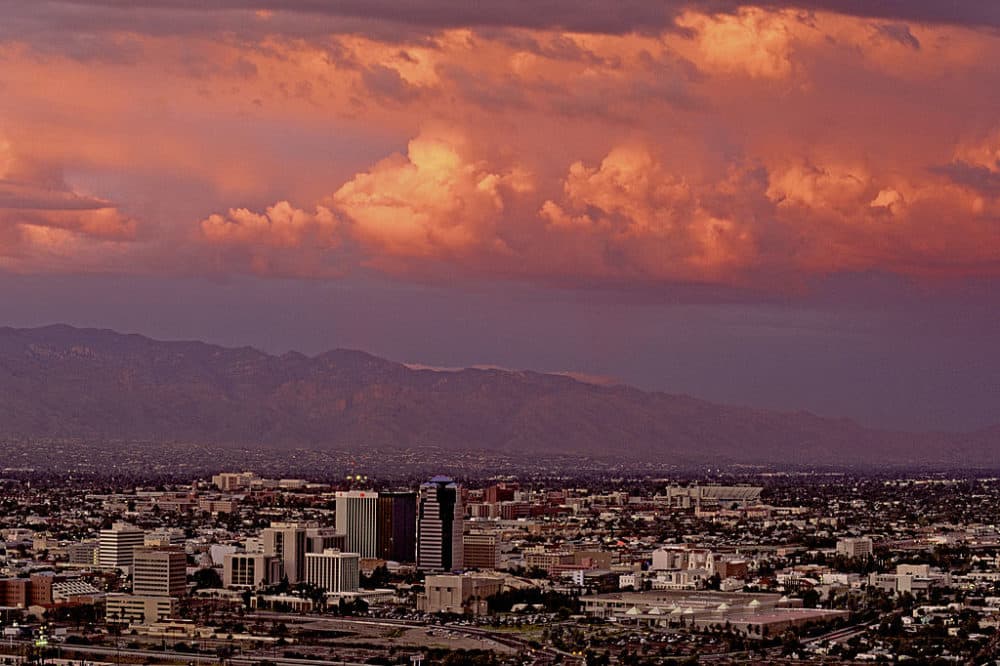Advertisement
Covering Climate Now 2021
Across The Southwest, Poor And Latino Neighborhoods Get Hotter Than Wealthier, Whiter Neighborhoods

A recent study shows that poor and Latino neighborhoods in the Southwestern U.S. are hotter than wealthier, whiter neighborhoods in the same cities.
In cities like Albuquerque, Phoenix, Las Vegas and Fresno, the temperature is on average 4 degrees warmer during average summer days and during heatwaves, according to research by the University of California, Davis and American University in Beirut. It's a dangerous formula as the climate gets even hotter.
Take Coachella Valley in Southern California, for example. The low-income areas in the region are dry deserts with no shaded structures and single-story homes, but the wealthier parts of town look like an “oasis” in comparison, says Jake Dialesandro, the study's lead author. Shade provided by vegetation and more easily cooled LEED buildings keep wealthier areas cooler.
“It's not that the heat is seeking out low-income neighborhoods,” he says. It's because these areas often lack vegetation and have more concrete and pervious surfaces.
People often respond to urban heat by cranking up the air conditioning, but adding $25 more to the electric bill to stay cool isn’t feasible for low-income people in these neighborhoods, he says. And extreme heat can cause illness or even death.
“If you have to decide between, ‘I have to pay my rent or I have to feed my children or I can run the AC,’ AC is going to be the lowest priority,” he says, “which puts you susceptible to this heat-related sickness and, God forbid, heat-related mortality.”
Studies show that redlined neighborhoods are vulnerable to extreme heat — which makes this a climate justice issue, he says. Dalesandro hopes his research will find more qualitative data that can inform policies to help give impacted communities more resources
“Because in a city like Phoenix or Bakersfield, California, you can't go and cool the entire city,” he says. “It's just not realistic.”
Planting more trees in vulnerable neighborhoods would reduce the heat and the carbon footprint, he says. In these dry cities, this would require allocating limited water resources to plant more vegetation.
Changing black roofs to a lighter shade would increase the albedo, the amount of light reflected by a surface, and help cool down the inside of homes in these neighborhoods, he says.
Advertisement
“All these climate projections for mid-century, late-century show that cities are going to warm an additional 3, 4 or 5 degrees. I'm expecting the problem to get worse with the temperature increase,” he says. “But if we are able to do something, we can mitigate and hopefully mitigate it completely.”
Beki Quintero, who lives in the Sunnyside neighborhood on the south side of Tucson, Arizona, says it's hotter where she lives compared to other neighborhoods in the city. In a valley surrounded by mountains, her part of town doesn’t get the same rain or greenery compared to others.
The hottest days of the year reach up to 115 degrees, she says, and most people stay inside and drink a lot of water. Most people in the neighborhood don’t have air conditioning, and instead use fans or swamp coolers.
“I feel sorry for people who are having to catch the bus to go places because they have to be outside and there's very little shade around the bus stops,” she says. “And so you'll see people with T-shirts over their head to protect themselves from the sun and see little kids with red, red faces standing at the bus stop with their parents. It's really sad.”
A leader for the Sunnyside Neighborhood Association, Quintero says some of her friends recently donated trees to plant in the south side after an article about the heat ran in the paper.
The association has been planting trees in specific areas for over a decade. Trees planted in 2009 along a street where kids walk home from school are now starting to produce much-needed shade, she says.
Living in the neighborhood since she was born, Quintero says residents of the south side do the best they can to mitigate the heat.
“We don't complain because my dad taught us that if you complain, you better come up with a solution. So it's hot, we can plant trees,” she says. “You just do what you can to better your community.”
Julia Corcoran produced and edited this interview for broadcast with Todd Mundt. Allison Hagan adapted it for the web.
This segment aired on April 22, 2021.

